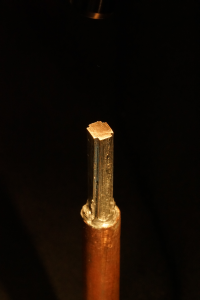The EU SOFT Innovation Prize for fusion research in the amount of EUR 50,000 is awarded to a team of researchers of Karlsruhe Institute of Technology (KIT) and the Swiss Plasma Center (SPC). Scientists of the Institute for Technical Physics of KIT have developed a novel superconducting conductor concept. Thanks to its energy-efficient current transport, it might be used as a basic element in future high-current cables of fusion power plants, industrial facilities, or DC power grids. Today, the prize was awarded at the Symposium on Fusion Technology (SOFT) in Prague.
“Sustainable energy sources and, above all, the reliable distribution of energy are major elements of the energiewende,” Professor Holger Hanselka, President of KIT, says. “The prize reflects KIT’s essential contribution to research, to the transformation of the energy system, and to the viability of our society.”
“Our novel conductor design with a cross-shaped cross section can efficiently transport more current than comparable cables and it is very easy to produce,” Dr. Walter Fietz and Dr. Michael Wolf, the developers of the CroCo conductor concept, emphasize. “We are highly honored by this EU prize for our concept. This illustrates its high application potential.”
The cross conductor, briefly called CroCo, developed by KIT consists of high-temperature superconducting (HTS) tapes of two different widths. These tapes are stacked and soldered over their full length, with a cross being formed in the cross section. Additional slight twisting of the tapes optimizes magnetic properties of the conductor. Finally, the conductor is packed into a copper tube, with the gaps between the cross and the tube being filled with solder. “In this way, the flat, tape-shaped superconductor is used to build a round cable, the shape of which facilitates further processing with standard processes,” Fietz and Wolf explain. The patent application for the prototype production facility for the continuous production of CroCo conductors from superconducting tapes has already been filed.

The inner conductor of CroCo consists of flat, superconducting tapes of different widths. (Photo: KIT)
High-temperature superconductors are ceramic materials that exhibit advantageous properties, such as resistance-free current transport at temperatures of typically minus 200 degrees Celsius. However, long lengths can only be produced as micrometer-thin coatings on metal tapes. The original idea to wrap flat, superconducting tapes in copper to form a cylinder was developed by the Swiss Plasma Center. Fietz and Wolf picked up this idea and developed the CroCo concept. CroCo contains more superconductor material and can be produced more stably and easily by the prototype production facility. Depending on the cooling temperature, energy transmission cables based on the CroCo concept might carry ten to hundred times more current than uncooled copper cables.
In fusion power plants, e.g. ITER, high-current cables for currents of up to 68,000 Ampere will be required for power supply of the superconducting coils generating the plasma-confining magnetic field. Cables with a current-carrying capacity of 10,000 to more than 100,000 Ampere DC are also needed for energy-intensive industries, such as aluminum smelters, computing centers, electrolytic deposition of chemical elements, or energy production in offshore wind parks. In connection with the “energiewende”, superconducting cables may be used to establish direct voltage grids for transmitting renewable energies from the producer to the consumer without any losses in the future. Superconductors might help minimize material consumption and installation expenditure, space consumption, and transmission losses as well as heat production.
The SOFT Innovation Prize honors excellent ideas and developments in fusion research and is awarded at the Symposium on Fusion Technology (SOFT). The main criteria are originality, outstanding achievements, economic relevance, and prospects of success. The prize money is to be used for the further development and commercialization of the technology. The SOFT Innovation Prize is supported by the Horizon2020 Euratom Research and Education Programme 2014 – 2018. www.soft2016.eu
Scientific publications on CroCo:
ieeexplore.ieee.org/xpl/articleDetails.jsp?arnumber=7399707
In spring this year, KIT started to coordinate the BMBF-funded consortium “ENSURE – New Power Grid Structures for the Energy Turnaround” within the framework of the Kopernikus projects for the energy turnaround “energiewende” of the federal government. The projects are aimed at developing and testing efficient and viable grid structures combining centralized and decentralized energy supply. The ENSURE consortium wants to answer the question: What is a technically, economically, and socially reasonable power grid structure and which fractions of centralized and decentralized supply does it comprise?
More Information:
http://www.kit.edu/kit/english/pi_2016_049_ensure-is-to-condition-grids-for-the-energy-turnaround.php
More about the KIT Energy Center: http://www.energy.kit.edu
In close partnership with society, KIT develops solutions for urgent challenges – from climate change, energy transition and sustainable use of natural resources to artificial intelligence, sovereignty and an aging population. As The University in the Helmholtz Association, KIT unites scientific excellence from insight to application-driven research under one roof – and is thus in a unique position to drive this transformation. As a University of Excellence, KIT offers its more than 10,000 employees and 22,800 students outstanding opportunities to shape a sustainable and resilient future. KIT – Science for Impact.

